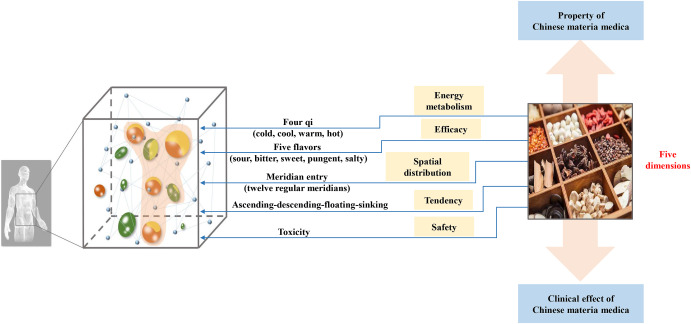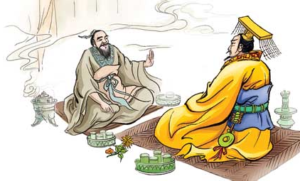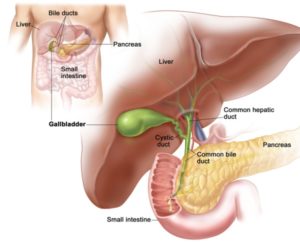Chinese medicinal properties and actions are generalized extractions of the principles and traits of Chinese medicinal functions, commonly referred to as “medicinal nature.” The five flavors, ascending and descending, floating and sinking (of qi movement or medicinal action), channel entry, toxicity, and the four qi (also known as the four natures) are among its contents. Reinforcing healthy qi and dispelling pathogens, removing etiological factors, restoring coordination of zang-fu organ function, correcting abnormal exuberance or debilitation of yin or yang, and allowing the body to return to normal as much as possible are the basic principles of TCM’s approach to disease prevention and treatment with Chinese medicines.
Because each Chinese medicine has special qualities that ancient TCM doctors referred to as its “preference nature,” Chinese medicines may perform the aforementioned tasks and directly target any pathogenic state. It is thought that the aberrant exuberance or debilitation of yin or yang that diseases exhibit can be corrected by medical preference nature. Both positive and negative effects are part of how Chinese medicines work on the body. The therapeutic benefit of medications should be thoroughly and sensibly employed in the clinic, and unpleasant reactions should be minimized. These are the fundamental tenets of clinical medicine and the assurance of high efficacy in medications and safe pharmaceutical practices.
Based on the Chinese medicinal’s object (materia medica), characteristics of Chinese medicinals include their shape, color, flavor, taste, and texture (light or heavy, sparse or dense, hard or soft, moist or dry). However, the human body’s responses to medication—the subject being the human body—are used to summarize the characteristics and effects of Chinese medicines. In order to explain the processes of therapeutic action, ancient TCM physicians typically connected these two. However, the meanings and observation objects of Chinese medicinals varied significantly, as do their traits, attributes, and activities. They shouldn’t be mistaken or utilized sporadically.
Four Qi
Four qi, also known as “four natures,” refer to the four different medicinal natures, such as cold, heat, warm, and cool. It reflects the characteristics of how medicinals affect the exuberance or debilitation of yin or yang, and change of cold or heat in the human body. It is one of the important concepts of describing medicinal functions. Moreover, there is another qi called “neutral nature,” which refers the medicinals not having obvious cold or heat nature. However, this is just relative, in fact, these medicinals still have slight warm or slight cold natures, and they are not beyond the scope of four qi. Medicinal natures (cold, heat, warm, and cool) are summarized from the reactions of medicinals on the human body and they are op- posite to the cold or heat property of treated diseases. In other words, medicinal natures are determined according to the reaction of medicinals on the human body and are relative to the cold or heat property of disease and syndrome. Medicinals that can alleviate or eliminate heat pattern usually have cold or cool nature. For example, Gypsum Fibrosum (shi gao) and Radix et Rhizoma Sophorae Tonkinensis (shan dou gen) can treat the heat pattern with symptoms of fever, thirst, swelling, and pain of the throat, and reddish complexion and eyes, as well as can clear heat and drain fire, and relieve sore throat and resolve toxins. These medicinals are considered as cold or cool in nature. On the contrary, medicinals that can relieve or eliminate cold pattern usually have heat or warm nature. For example, Rhizoma Zingiberis (gan jiang), Cortex Cinnamomi (rou gui), and Radix Aconiti Lateralis Praeparata (fu zi) can treat the cold pattern with symptoms of cold pain in the stomach cavity and abdomen, extreme cold of the four limbs due to cold moving proximally (sì zhī jué nì), and pale complexion, as well as have the effects of warming the center and dissipating cold, and restoring yang to rescue counterflow (desertion). These medicinals are indicated as having warm or heat nature.
To understand the four qi theory, medicinals must be selected according to the medicinal nature. There are three prin- ciples. (1) Select corresponding medicinals based on cold and heat properties of disease and syndrome. Disease with heat pattern should be treated with medicinals of cold nature. Disease with cold pattern should be treated with medicinals of heat nature. For example, high fever and excessive thirst caused by external pathogen can be treated with Gypsum Fibrosum (shi gao), Rhizoma Anemarrhenae (zhi mu), and Fructus Gardeniae (zhi zi) with cold nature; yang collapse verging on de- sertion can be treated with Radix Aconiti Lateralis Praeparata (fu zi) and Rhizoma Zingiberis (gan jiang) with heat nature.
(2) Select corresponding medicinals based on the different degree of cold and heat in disease and syndrome. For example, yang collapse verging on desertion should be treated with herbs in extreme hot nature, such as Radix Aconiti Lateralis Praeparata (fu zi); but the general abdominal pain due to center cold (cold in the middle jiao) should be treated with herbs in warm nature, such as roasted Rhizoma Zingiberis Recens (wei sheng jiang). (3) Disease or syndrome with both cold and heat patterns should be treated with medicinals with both cold and heat natures. The respective dosage of these medicinals should be determined based on the degree of cold and heat condition. (4) Diseases or syndromes with the pattern of true cold with false heat or the pattern with true heat with false cold should be treated with medicinals with heat nature or medicinals with cold nature, respectively. If necessary, paradoxical assistant medicinals with opposite medicinal nature can be added.
Five Flavors
Five flavors are based on different effects. Chinese medicinals have sour, bitter, sweet, acrid, and salty flavors according to their different biological activities. It is not only the concise summary of medicinal functional activity, but also the real taste of some medicinals. The theory of five flavors provides a tool for TCM to reason, summarize, and explain the medicinal efficacy. Five flavors are felt initially, determined by tasting medicinal, and consistent with their flavors in healthy people. For example, Saccharum Granorum (yi tang) has a sweet flavor; Radix Scutellariae (huang qin) is bitter in taste; Rhizoma Chuanxiong (chuan xiong) has a acrid flavor; Fructus Mume (wu mei) is sour in taste; and Sargassum (hai zao) has a salty flavor. A close correlationship and correspondence between medicinal flavors and efficacy exists. For example, medicinals with activities of exterior-releasing, (qi-) moving and dissipating are usually acrid in taste; medicinals with activities of deficiency-supplementing and spasm-relaxing are usually sweet in taste; medicinals with activities of astringing the lung and intestines are usually sour in taste; medicinals with activities of descending, purging, and dampness-drying are usu- ally bitter in taste; and medicinals with activities of softening hardness and dissipating masses are usually salty in taste. In addition, if medicinal activities cannot be explained by flavor tasted by mouth, people can conversely figure out medicinal flavor according to the aforementioned relationship. This deduced flavor is not associated with flavor tasted by mouth. For example, Radix Puerariae Lobatae (ge gen) usually has activities of promoting fluid production and quenching thirst, vent- ing pathogen through the exterior, and promoting eruption of papules in the clinic, but the sweet flavor tasted by mouth can only explain its activities of promoting fluid production and quenching thirst, but is difficult to explain its activities venting pathogen through the exterior and promoting eruption of papules. Therefore, according to the relationship between activi- ties (exterior-releasing, venting, and dispersing) and acrid in taste, the acrid flavor is endued to Radix Puerariae Lobatae (ge gen). So Radix Puerariae Lobatae (ge gen) not only has a sweet flavor, but also an acrid flavor. After countless deductions and comparisons, TCM physicians gradually realize that medicinal flavor obtained by this kind of practice and deduction is more reasonable and effective in clinical practice. Therefore, in today’s practice, medicinal flavor is mainly determined based on medicinal efficacy and referred by the flavor tasted by the mouth.
Generally speaking, medicinals with different flavors have different effects on the human body. (1) Acrid: the acrid medicinals can dissipate and move; therefore they have the activities of dispersing, moving qi, and invigorating the blood. For example, Herba Schizonepetae (jing jie) and Herba Menthae (bo he), for treating exterior pattern; Rhizoma Cyperi (xiang fu), for treating qi stagnation; and Rhizoma Chuanxiong (chuan xiong), for treating blood stasis, are acrid in taste. The acrid medicinals can usually consume qi and damage the liquid (thin fluid), so patients with qi deficiency and fluid inadequacy should use them with caution. (2) Sweet: the sweet medicinals can supplement, moderate, and harmonize; therefore they have the activities of supplementing deficiency, harmonizing the center, moderating spasms, and harmoniz- ing different medicinal natures. For example, Radix et Rhizoma Ginseng (ren shen), Radix Rehmanniae Praeparata (shu di huang), Fructus Jujubae (da zao), and Fructus Lycii (gou qi zi), for treating deficiency pattern; Saccharum Granorum (yi tang) and Radix et Rhizoma Glycyrrhizae (gan cao), for treating spasm with pain and harmonizing medicinal nature, have a sweet flavor. Some sweet medicinals, such as Mel (feng mi) and Radix et Rhizoma Glycyrrhizae (gan cao), can resolve toxins from drugs and food. In addition, sweet medicinals usually have a moist texture and can moisten dryness. Moreover, most sweet medicinals are greasy, can easily influence digestion, and cause abdominal fullness; so patients with dampness obstruction, food accumulation, and abdominal flatulence due to qi stagnation should use them with caution. (3) Sour: the sour medicinals can astringe and have the activities of restraining (preventing something from leaking) and consolidat- ing (essence). For example, Galla Chinensis (wu bei zi), for treating chronic diarrhea and dysentery; Fructus Mume (wu mei), for treating chronic cough; Fructus Schisandrae Chinensis (wu wei zi), for treating spontaneous sweating and night sweating; Fructus Corni (shan zhu yu), for treating seminal emission or spontaneous seminal emission; and Halloysitum Rubrum (chi shi zhi), for flooding and spotting (uterine bleeding) and morbid leukorrhea in large amounts, are sour in taste. Moreover, sour medicinals, such as Fructus Chaenomelis (mu gua) and Fructus Mume (wu mei), can promote fluid production and calm roundworms. Most of sour medicinals can astringe pathogens, so patients with pathogens that have not been removed should use them with caution. (4) Bitter: the bitter medicinals can discharge, and dry and strengthen yin; therefore they have the activities of clearing and draining fire-heat, discharging and descending counterflow of qi, purging or promoting defecation, drying dampness, and draining fire to preserve yin. For example, Radix Scutellariae (huang qin) and Fructus Gardeniae (zhi zi) have a bitter flavor, can clear heat and drain fire, and treat pattern of fire-heat accumulated in interior; Semen Armeniacae Amarum (ku xing ren) and Semen Lepidii (ting li zi) are bitter in taste, they can lower and discharge lung qi, relieve panting, and can treat cough and panting due to lung qi counterflow; Radix et Rhizoma Rhei (da huang) and Fructus Aurantii Immaturus (zhi shi) are bitter in taste, can discharge heat and promote defecation, and treat constipation due to heat accumulation; Radix et Rhizoma Gentianae (long dan) and adix Sophorae Flavescentis (ku shen) have a bitter flavor, can clear heat and dry dampness, and treat damp-heat jaundice; Rhizoma Atractylodis (cang zhu) and Cortex Magnoliae Officinalis (hou po) can dry dampness with bitter and warm natures and treat dampness obstruction in the middle jiao; Cortex Phellodendri Chinensis (huang bai) and Rhizoma Anemarrhenae (zhi mu) are bitter in taste, can drain fire to preserve yin, and treat steaming bone fever and tidal fever due to yin deficiency that causes vigorous fire. Bit- ter medicinals usually can damage liquid (thin fluid) and stomach, so patients with fluid consumption and spleen-stomach deficiency should not use them a lot. (5) Salty: the salty medicinals can soften and purge; therefore they have the activities of softening hardness and dissipating masses, and relieving constipation by purgation. For example, Natrii Sulfas (mang xiao), for treating constipation due to heat accumulation; Sargassum (hai zao) and Thallus Eckloniae (kun bu), for treating goiter and scrofula; Carapax Trionycis (bie jia) and Concha Ostreae (mu li), for treating concretions and conglomerations (lower abdominal masses; zhēng jiă), are salty in taste. (6) Astringent: the astringent medicinals can astringe and have simi- lar activities as those as sour medicinals. For example, Endoconcha Sepiae (hai piao xiao), for treating uterine bleeding and hematemesis; Semen Nelumbinis (lian zi), for treating seminal emission and morbid leukorrhea; and Pericarpium Granati (shi liu pi), for treating chronic diarrhea and dysentery, are astringent in taste. (7) Bland: the bland medicinals can percolate; therefore they have the activities of promoting urination and percolating dampness. For example, Poria (fu ling), Polyporus (zhu ling), Rhizoma Alismatis (ze xie), and Medulla Junci (deng xin cao) are bland in taste.
Four Actions
Ascending and descending, as well as floating and sinking refer to the different tendencies of Chinese medicinals on the human body. These tendencies are opposite to that of the treated disease, but similar to the location of the treated disease. It is one of the concepts that explain the properties of medicinal function. Generally, light medicinals, such as flower, leaf, bark, and branch, usually belong to the ascending and floating medicinals, such as Folium Perillae (zi su ye), Flos Chrysan- themi (ju hua), and Folium Mori (sang ye). Heavy medicinals, such as seed, fruit, mineral, and shell usually belong to the
descending and sinking medicinals, such as Fructus Perillae (zi su zi), Fructus Aurantii Immaturus (zhi shi), Magnetitum (ci shi), Concha Ostreae (mu li), and Haematitum (dai zhe shi). The clinical therapeutic effects of Chinese medicinals are the main basis used for determining the medicinal nature: ascending and descending, or floating and sinking. For example, Rhizoma et Radix Cynanchi Stauntonii (bai qian) can dispel phlegm, direct qi downward, and is good at treating cough and panting, excessive phlegm, and counterflow of qi with an excess pattern; so its medicinal nature is descending and sinking. Radix Platycodonis (jie geng) can dissipate and elevate lung qi, diffuse the lung, and relieve sore throat, and specialize in treating cough with profuse phlegm, sore throat, and hoarseness,; so it has the medicinal nature of ascending and floating. Generally speaking, the ascending and floating medicinals can act upward and promote pathogens outward, and have the effects of raising yang and releasing the exterior, dispelling wind and dissipating cold, inducing vomit, and opening the orifices (resuscitating), and are suitable for the prevention and treatment of diseases in the upper or exterior, or diseases with sunken tendency. The descending and sinking medicinals can act downward and interior, and have the effects of purgation, clearing heat, promoting urination and percolating dampess, tranquilizing the heart and calming the mind, subduing yang and extinguishing wind, disperse accumulation and guiding out (food) stagnation, directing counterflow downward and ar- resting vomiting, astringing and consolidating (essence), relieving cough and calming panting, and they are suitable for the prevention and treatment of diseases in the lower or interior body, or diseases with tendencies of ascending and counterflow.
Channel Entries
Channel entry refers to the selective therapeutic actions of Chinese medicinals acting on one part or several parts of the human body. This means that some medicinals have a special affinity to enter or interact with certain zang-fu organs. Therefore, they can be mainly used to treat pathological conditions present in these parts of the human body. Channel entry points out where the medicinal can be used and explained where the medicinal is effective, so it is one of the basic concepts of medicinal nature to guide clinical practice. The formation of channel entry theory is based on the theories of zang-fu and channel-collateral, as well as the efficacy of medicinals on specific diseases and syndromes. For example, Fructus Perillae (zi su zi) and Rhizoma et Radix Cynanchi Stauntonii (bai qian) can treat cough and panting, which are caused by a disorder of lung function, so they attribute to the lung channel. Sclerotium Poriae Pararadicis (fu shen) and Semen Platycladi (bai zi ren) can treat palpitation and insomnia, which are caused by a disorder of heart function, so they attribute to the heart channel. In clinical practice, doctors can select attributive medicinals according to affected zang-fu or channel-collateral. For example, heat patterns include lung-heat pattern and liver-heat pattern. To treat cough and panting with lung-heat pattern, doctors should select the medicinals that attribute to the lung channel and specialize in clearing lung-heat, such as Radix Scutellariae (huang qin) and Cortex Mori (sang bai pi). To treat liver-heat pattern or liver-fire pattern, doctors should select the medicinals that attribute to the liver channel and specialize in clearing liver-fire, such as Radix et Rhizoma Gentianae (long dan) and Spica Prunellae (xia ku cao). Moreover, doctors can also select medicinals according to the role of transmission and change of disease through the zang-fu organs or channel and collateral. For example, if cough and phlegm panting is caused by liver-fire invading the lung, doctors cannot just use medicinals that attribute to the lung channel only. They should select medicinals that attribute to the lung channel and can clear lung heat and dissolve phlegm, such as powder of Concha Meretricis seu Cyclinae (hai ge fen), as well as medicinals that attribute to the liver channel and can clear heat and cool the liver, such as Indigo Naturalis (qing dai). In this way, the medicinals can clear both liver- and lung-heat to heal cough and panting. If patients with cough and phlegm panting complicate with spleen deficiency, doctors should select medicinals that attribute to the lung channel and can relieve cough and dissolve phlegm, as well as medicinals that attribute to the spleen channel and can fortify the spleen to disperse phlegm. In this way, the medicinals can heal coughing and panting.




